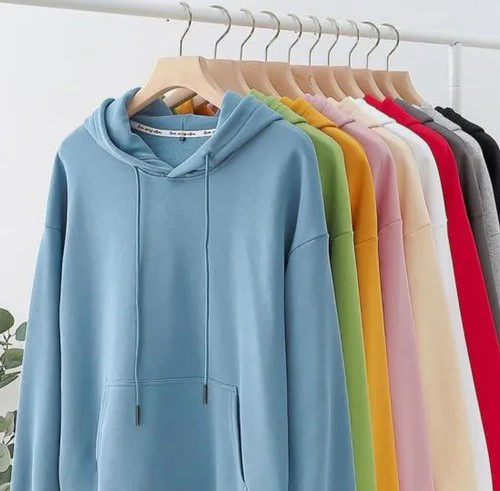Hoodies today are much more than just a piece of clothing we all have: they are a fashion necessity. Their fabric determines how good or bad they feel and how useful they are, so it is important to pick the right material. In this article, we look at some of the most commonly used hoodie fabrics.
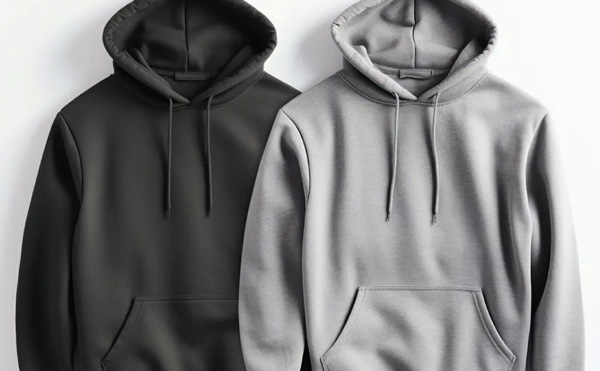
1) Top 10 Hoodie Fabrics and Their Characteristics
Hoodie material is the most important factor that can change your entire perspective about that particular hoodie. So, for your convenience, let’s discuss the top 10 hoodie fabrics in detail. Let’s get started!
i) Cotton
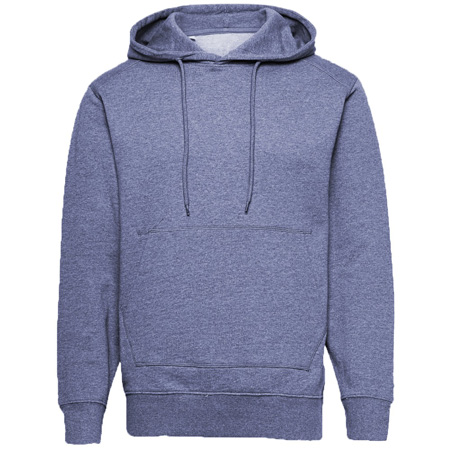
It is understood that one of the conventional materials used for making hoodies is Cotton. It’s highly regarded due to its breathability and soft texture. You know cotton is a natural fibre that feels smooth on the skin, making it a perfect option for those with skin sensitivities or allergies. Cotton Hoodies are lightweight and relaxed-fit clothing that can be worn on a normal day out.
- Benefits: Soft texture materials that are breathable and hypoallergenic in nature.
- Drawbacks: Less durable than a synthetic material making it shrink more after washing.
- Best For: Best material to use for hypersensitive wearers. It is best for comfortable summer casuals. One more thing that it is ideal for businesses dealing in ventilated cotton apparel.
ii) Polyester
Polyester is an artificial fabric that is noted for its strength and ability to absorb moisture. Polyester hoodie is widely used for sports and outdoor hoodies as it helps to remain dry by drawing moisture away from the skin.
- Benefits: Durability, wrinkles, quick to dry.
- Drawbacks: Not as smooth, and stale smells if improperly washed.
- Best For: Great option for sports persons and people who enjoy the outdoors. It is appropriate for all weather. Moreover, it is considered best for sporting and training attire. So, we can expect that it is useful for brands dealing in sturdy, quick-drying garments.
iii) Cotton-polyester blends
This hoodie fabric is essentially a combination of cotton and polyester raw materials. So, you are able to have the best of both worlds when you wear this fabric. It allows you the softness and breathability of cotton alongside the strength and moisture-wicking properties of polyester. Yes! Really this blend fabric has been used by a great number of hoodie manufacturers.
- Benefits: Strong with a balanced softness.
- Drawbacks: The breathability is slightly lower compared to pure cotton.
- Best For: It is suitable for all skin types, comfortable, looks good, and affordable, these clothes are easy to maintain and use for any occasion. These attributes make them great for businesses that provide active and casual wears.
iv) Fleece
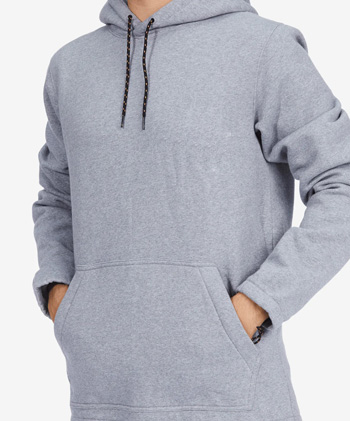
Fleece is a polyester fabric that is made synthetically to imitate the softness and warmth of wool. But, it is a lot lighter which makes it perfect to be worn during winter months as it is extremely warm.
- Benefits: It is warm, cozy and lightweight.
- Drawbacks: It can easily Pilled over time.
- Best For: Best option for people living in tough cold conditions, conditions, great for winter, and suitable for warm hoodies and even loungewear. Fleece is highly recommended for brands providing warm insulated clothes.
v) French Terry
French terry is a form of knit that has soft loops on one side and a flat knit surface on the other. Due to its lightweight and breathability, it has a layering function in transitional weather.
- Advantages: Soft to the skin, absorbs well, and versatile to use.
- Disadvantages: Lacks warmth in comparison to fleece and wool.
- Best Usage: Great for people looking for lightweight sweaters that can be worn in spring and autumn. Moreover, it is perfect for running and lounging. It can be considered ideal for businesses selling fashionable comfortable clothes.
vi) Wool
Wool is considered a natural fiber and is praised in the cold as it is a great insulator making it one of the prime raw materials used to make hoodies in cold environments. Wool hoodies are reasonably warm and have an elegant touch to them.
- Advantages: Warm, elegant, and great insulation to use.
- Disadvantages: Needs extra care, such as hand washing and dry cleaning.
- Best Usage: Great for people living in cold places, ideal for winter. It is good for high-end formal and luxury hoodies, and it is recommended for high-end fashion brands.
vii) Bamboo
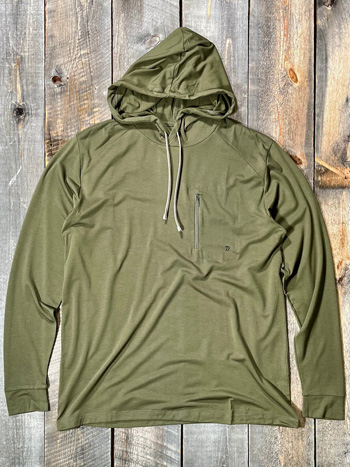
Bamboo hoodie fabric material is an eco-friendly option that is becoming widely used in the clothing world. It is soft, breathable, and does not induce allergic responses making it comfortable to use for those with sensitive skin.
- Advantages: Good for the environment, soft, and absorbs well.
- Disadvantages: May tend to cost more than other materials.
- Best Usage: Good for eco-conscious people, appropriate in any weather, perfect for green and non-allergic apparel. So, it is wise for Eco-friendly fashion brands.
viii) Spandex (or Elastane)
Hoodies made with an elastic material like Spandex are great for activewear since they allow for ease of mobility while providing a tight fit. It is also a great addition when blended into other fabrics to make them more elastic since they can stretch greatly.
- Pros: Spandex is really easy to maintain.
- Cons: The lack of a heating property may not make the material useful in colder climate conditions.
- Best For: Suitable for fitness lovers, can be worn regardless of the season, perfect for trained clothes and exercise. It is mandatory for advertisers of body-fitting outfits.
ix) Recycled fabrics
Recycled polyester and cotton are gaining popularity. They have their own unique selling point as they promote sustainability and fashion. These materials are environmentally friendly and so have low carbon footprints.
- Pros: Great for the environment, durable, and long-lasting.
- Cons: Being environmentally friendly has its drawbacks as the cost is too high and their availability is very low.
- Best For: Ideal for shoppers focused on eco-friendliness, appropriate for all climates, perfect for supporting sustainable fashion, and ideal for brands that emphasize ethical and sustainable clothing.
x) Nylon
A fabric that is used in performance hoodies, this material is known to be light and extremely tough. It is also water resistant and better suited for outdoor activities.
- Pros: Really tough, water resistant, and dries out rather quickly.
- Cons: To some people, it might feel a bit scratchy and uncomfortable to wear.
- Best For: Nylon is a deal for the nostalgic explorers or those who work outdoors, appropriate for the winter season. It is excellent for outerwear that needs to be waterproof and windproof. Well, it is a robust option for the athlete’s apparel industry.
2) Factors to Consider When Choosing Hoodie Material
If you want to make a wise choice while buying a hoodie material, there are certain elements that you must have to consider. Some important of them are discussed here below;
? Climate and Season: The weather plays a significant role in determining the best hoodie material. There are three considerations warm weather, cold weather, and transitional. Warm weather requires lightweight fabrics such as cotton or French terry. For colder weather, it is best to opt for fleece or cool materials. If the weather is moderately warm, using a blend of cotton and polyester, or using bamboo, is good enough. ( Click here to learn about the best replica sites in China )
? Purpose: The aim of the hoodie affects the fabric choice. Casual hoodies are generally comfy, hence the fabric used needs to be soft. If the purpose of the hoodie is for sports or outdoor activities, it should be durable and should be able to soak moisture easily. If someone is eco-friendly, fabrics made from recycled materials or bamboo work best.
? Comfort and Fit: The material you use affects the way the garment feels when worn. A hoodie made from a bamboo and cotton blend is known to be soft. However, if the aim of the hoodie is for it to be snug, it could be blended with spandex.

? Maintenance: Some fabrics require more effort than others. For example, fabrics such as cotton and blends are easy to maintain, while wool and bamboo have special washing instructions. Polyester is easy to clean and durable but these clothes tend to hold smells which is a downside.
? Consider a trusted supplier for investing: When buying hoodies or the material for hoodies, it is crucial to consider a trusted supplier. Yes! It will ensure that the materials and stitching quality is on point. Meeno Group, which is a Yiwu-based Professional Chinese Sourcing Company, provides full assistance with importing items from China. They can assist with:
- Goods Sourcing: Understanding the customer’s needs and searching for the goods of their specification.
- Company Audits: Inspect suppliers and manufacturers to confirm ethical smart sourcing and compliance with business standards.
- Quality Control: Carrying out inspections aimed at ascertaining the quality of goods.
- Logistics: Organizing the delivery and clearance of goods through customs. ( Bill of lading information )
3) Hoodie Material and Style Trends
Style, comfort, fit, and functionality are all factors influenced by the material of a hoodie. And to some, this is the most important consideration. At times, oversized hoodies can have a glam touch and the type of fabric to use is a sleek and comfy fleece.
For layered garments fitted ones in lightweight fabrics such as French terry are optimal during transitional weather. Spandex is incorporated into activewear hoodies for ease of movement and a snug fit.
Material trends in hoodies manage to combine aesthetics with ecological know-how. Fleece hoodies, particularly oversized, continue to be in vogue due to their ‘smart casual’ look and feel. French terry designs are great for layering. The issues of fashion in sustainable apparel drove the search for recyclable fabrics and bamboo because they were eco-friendly and comfortable.
4) Conclusion
Hoodies can be described as a combination of comfort, functionality, and style, and not just casual clothing. So, as a result, the correct hoodie material needs to be selected. You need to find a suitable material for your needs, be it lounging, exercising, or fashion and style statement.
Acquiring intimate knowledge of the material attributes, intended use, environmental conditions, and care will definitely help you choose the best hoodie. Similarly, working with a reliable supplier like Meeno Group guarantees good quality products according to the parameters you are after. So wait for what? Click here and freely inform us about your plans!

